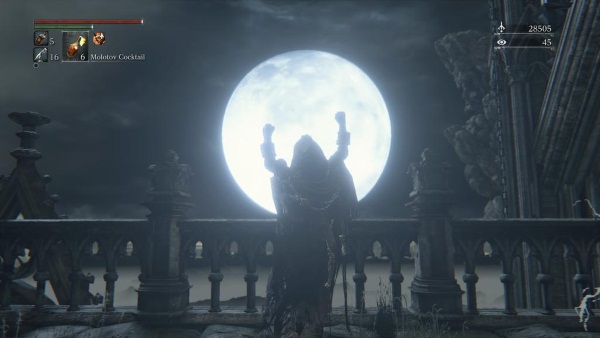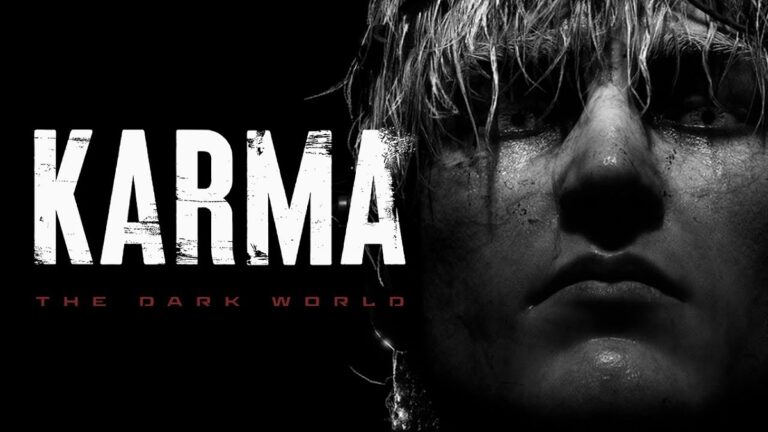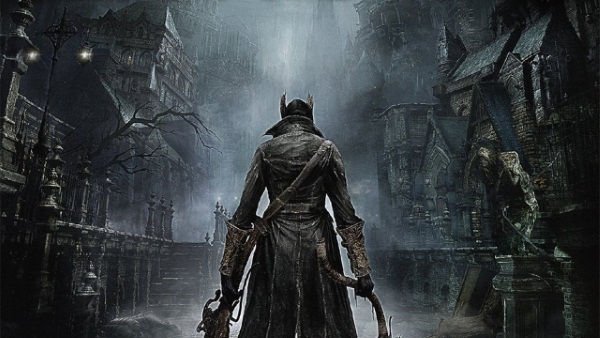
Welcome home, good hunter–Your presence somehow soothes. Those words are the first thing that echo throughout my mind whenever I think of my time spent playing Bloodborne. Despite its brutal, horrifying nature, there’s an odd calming presence to the game. Probably due in large part to the fact that Bloodborne, and the Souls games before it, have acted as a refuge from the overbearing hand holding of a lot of modern game design. In short, it is a game that treats the player with a degree of respect. Bloodborne is calisthenics for your mind; it fills you with intrigue, and pulls you into the world of Yharnam with a thoughtful narrative and brilliant mechanics. So let’s cleanse these foul streets, hunter.
Part of the charm of Demon’s Souls and Dark Souls 1 was the way they created memorable characters, storylines, and worlds without the practice of shoving a cutscene in the player’s face often. The storylines for the most part were something you could ignore if you were focusing on the gameplay, something that Dark Souls 2 was noticeably lacking (probably because Hidetaka Miyazaki did not direct that game). Thankfully the narrative of Bloodborne is presented more in the fashion of the first two Souls games than Dark Souls 2. The gist of the story is this: You’re a poor soul that’s unfortunately found your way into a city called Yharnam, a place that’s been enveloped in a plague that turns its citizens into beasts. Worse than that though, you’re now a denizen of a place called The Hunter’s Dream–an ethereal place that offers refuge from Yharnam, but is also a prison in and of itself. Whenever you die, you’ll return to the dream, and the only way to escape is to cure Yharnam of the plague of beasts.
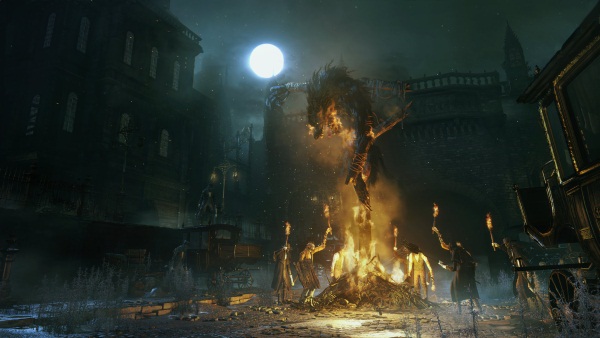
The story in Bloodborne is arguably even more hidden from the player than it was in any of the previous Souls games. Which in my opinion is a bit of a misstep only because the world From Software has created explores interesting themes such as how blind religious devotion can have disastrous ramifications. There’s so much glorious attention to detail, most of which can be unintentionally glossed over if you’re not paying attention. In the grand scheme of things this is not a bad thing, but it’s a bit of a shame that most players will probably miss out important story beats just due to how easily it is to miss them. Like everything in the game, the developers expect you too be very tentative with regards to the plot and narrative.
One way I would say Bloodborne does stumble in comparison to the previous games is interaction with its NPC side stories. In my first playthrough, most NPC interaction was limited to talking to people behind closed doors and windows, a far cry from storylines like that of Ostrava from Demon’s Souls or Solaire from Dark Souls. Again, this could just be because these kinds of storylines are more hidden though.
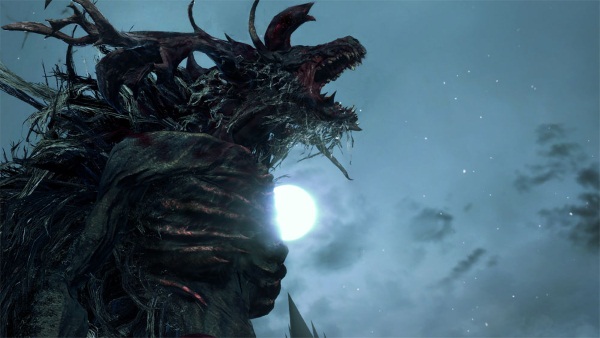
Bloodborne’s director Hidetaka Miyazaki has stressed that combat in the game is supposed to feel like a “fight for your life”, and I’m happy to say From Software has delivered in this regard and then some. There are times where I finished up a session of the game and straight up needed to do some stretches to relax a bit cause I was so tensed up while playing. Enemy encounters are not to be taken lightly ever; if enemies exhaust a combo on you that usually results in death. Your foes in the game are incredibly aggressive and have much better AI than anything in the Souls series. If you’re a veteran Souls player that played passively and liked to tank damage with shields and heavy armor, Bloodborne’s combat is about to rip the carpet out from under your feet. There are no light/medium/heavy armor types in this game, and the only shield available feels like it was put there as a cruel joke. Instead you must perfect the art of dashing, rolling, and staying in your opponent’s face to survive.
Probably the thing that makes the combat so frantic in this game is the new regain mechanic. If you are hit, there’s a small time window where if you strike back at your opponent then you can regain a small portion of health. A lot of fans were worried that this might make the game too easy, however this is certainly not the case. This regain mechanic rewards you for playing well and brutally punishes you for getting greedy. There were so many times where I died because I carelessly tried to spam my way back to full health only to be stomped into the ground.
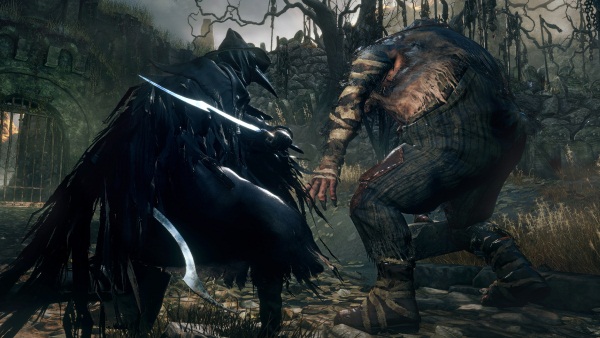
The weapons in Bloodborne really steal the show this time around. All of your melee weapons can be transformed at the tap of a button into another functional state. For example, the threaded cane starts off as a basic short sword, but when you transform it, it turns into a whip. You can transform your weapons mid-attack to create new combos of your own. There is so much more depth to the moment-to-moment combat in this game than there was in Demon’s Souls or Dark Souls–and that’s really saying something. The only thing that’s been hurt with the new combat is there’s not as much variety as there was in the Souls games. If you were a magic or ranged user in Souls, Bloodborne doesn’t have much of an alternative for you. Pistols and blunderbusses are only there to help with stunning enemies and do next to no damage and have terrible range.
The last thing I need to touch on regarding the combat is how Bloodborne is much more fair than Dark Souls 2 was. For the most part that game was easier than the other Souls games but it was also harder because it suffered from horrible hitboxes, cheap player tracking where enemies would always face you and spin around without moving their feet as if they were standing on a record player, and would often not react to getting hit. This made a lot of battles with the normal enemies stupidly unfair at times. Thankfully Bloodborne doesn’t suffer from any of these problems.
PVP and co-op are back and are more accessible than ever. You need only acquire certain items that can be purchased with insight at The Hunter’s Dream. You can even set a password on your co-op session so it’s easier than ever for a friend to join you. However, they balance this out brilliantly. If you initiate co-op, you also paint a target on yourself for invaders, and make it easier for them to invade your world. The best part about this is there are areas with more concentrated PVP exchanges due to a bell maiden NPC that helps link invaders in your world. It’s a nice trade off, making co-op easier to initiate while making PVP far more likely to happen.
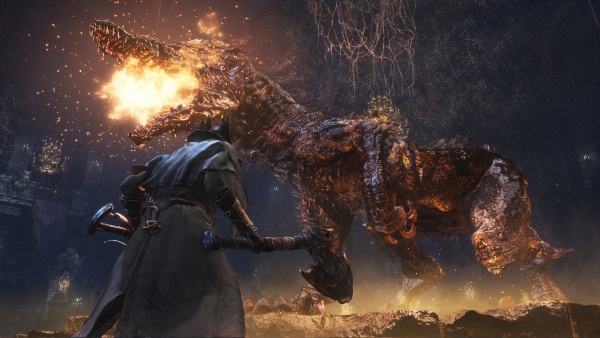
Now comes the moment where I touch on the thing that comes to everyone’s mind when discussing From Software’s games: the difficulty. Bloodborne is a difficult game, even a *very* difficult game at times. If I were to rank it among the Souls series, I’d say it’s tougher than Dark Souls 2 and Demon’s Souls but not quite as brutal as Dark Souls 1. The important thing to keep in mind here is I think this game even more than Demon’s Souls or Dark Souls 1 is incredibly fair, as there was really only one boss in the entire game that felt a bit cheap to me. It’s rewarding and instills an immense sense of accomplishment. Miyazaki is the master of creating games that subtly train you at getting better without condescending tutorials.
Dark Souls 1 was praised for the way levels would often branch off in different directions only to loop back in on themselves, something Dark Souls 2 was noticeably lacking as it was a much more linear game. Bloodborne is firmly in line with the former than the latter regarding level design. Yharnam really feels like a real place; you obviously have to suspend your disbelief about the monsters and whatnot, but everything is just so well-interconnected that it feels like a real city. It’s all thanks to absolutely brilliant level design. The Hunter’s Dream and the Chalice Dungeon were the only areas I came across that felt separate from the rest of the world. The Hunter’s Dream functions much like the Nexus in Demon’s Souls did where it acts as your place to level up, buy equipment, and warp to different locations in Yharnam.
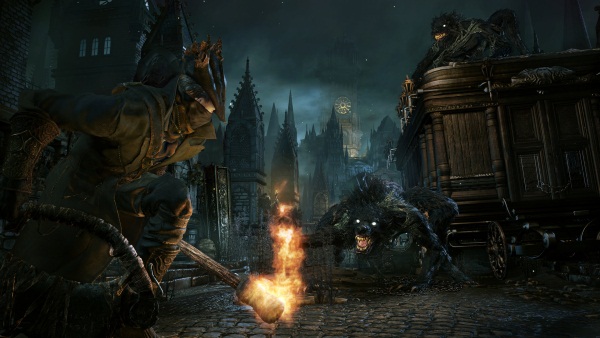
Beautifully grotesque would be the best way to describe the art direction of Bloodborne. While the game is probably best described as an action RPG, the beasts that occupy the streets of Yharnam are more horrific and creative than anything this side of a Masahiro Ito painting. I can’t remember the last time a game actually evoked revulsion in me, but Bloodborne was the first to do so in a long time. Not even exaggerating when I say that there was one enemy in particular that made me actually gag upon seeing it the first time. The plague of beasts is literally transforming people into beasts, and that theme is ever present in the art direction. Much like the combat in the game, you might need a breather once and a while from the gloomy streets just to recuperate. I suggest keeping some flowers on hand.
The visuals in general are pretty stellar, and while it’s not as visually impressive as say The Order: 1886 from a technical standpoint, the art direction makes it shine far beyond much of its peers. The game does suffer from a couple technical shortcomings, particularly the overly long loading screens which can really break the pacing in a game where you die a lot. Sony recently released a patch for the game that helped with these a bit though.
Being a joint venture between Sony and From Software, the production values of Bloodborne are noticeably higher than any of the Souls games that came before it. The soundtrack is where this is most apparent – it’s fully orchestrated and absolutely un-fucking-believable. There are times where I was in a duel with a particular boss and the music ramped up to fit the occasion and made me say aloud “YES IT’S TIME TO THROW DOWN” and other times where it was creepy and melodic during a fight with a disgusting boss and I was more like “NOPE NOPE GET AWAY”. The music hits the right beats and fits the tone of the game so well. The track Amygdala in particular makes my hair stand on end every time I hear it.
Bloodborne is a triumph of brilliant game design, and there’s so much thought put into every aspect of it that it will make many other “great” games feel straight-up lazy by comparison. Be it the frantic fight-for-your-life combat, the thrilling PVP exchanges, or the haunting soundtrack; this game just hits the nail on every head. If they weren’t already there, Hidetaka Miyazaki and his team at From Software have just solidified themselves as one of the best developers in the world. Very few games these days respect the intelligence of the player, but Bloodborne is content with hiding things from you. So, hunter; let the good blood guide your way, so that the world might be mended.
 (10 / 10)
(10 / 10)
The Holy Grail
 (10 / 10)
(10 / 10)
